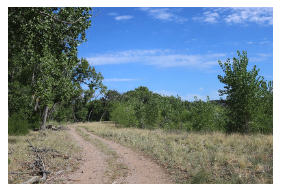September 7, 2019
Monitoring Restoration Success
Guest columnist this week: Alissa Freeman - Senior Program Specialist and Director of the pollinator-friendly NMSU Learning Garden at the NMSU Agricultural Science Center at Los Lunas.
Question:
I volunteered this year and helped plant coyote willow poles for a riparian restoration project. I wanted to follow up and learn about how scientists monitor the health of these wetland ecosystems following restoration.
- Eric L., Bernalillo
Answer:
I recently visited the Pueblo of Santa Ana, about 20 miles north of Albuquerque, and took a tour of these bosque restoration sites with Nathan Schroeder, Restoration Division Manager in the Pueblo of Santa Ana’s Department of Natural Resources, to better answer this question. The Rio Grande flood plain on the Pueblo has changed significantly in the past sixty years due to flood control and channelization projects, many of which have adversely affected the riparian and aquatic communities. Many of their restoration projects focus on restoring the river channel and both the active and historic floodplain. Through these restoration efforts, over 100 acres of riparian wetland habitat were created, six river miles of the Rio Grande were restored, saltcedar and Russian olive thickets were removed and replanted with 1,300 acres of cottonwood, and native wildlife habitat was restored. In particular, wild turkeys were reintroduced to these areas, and populations are going strong and gobbling on!

Along with plant surveys and wildlife monitoring, one of the key ways to determine the health of these wetland ecosystems is by observing something you might not expect—dragonflies and damselflies (order Odonata). Dragonflies and damselflies serve as an indicator species of the health of these ecosystems because their larvae develop in the water and are sensitive to habitat quality. The absence of dragonfly and damselfly species may indicate water quality issues from pesticides, agricultural runoff, bank erosion, or other water contaminants. Although there are other macroinvertebrates (animals lacking a backbone that is visible to the naked eye) that can be used to indicate the system’s health, sampling and monitoring these other insect invertebrates can be impractical and time-consuming, whereas dragonflies and damselflies are relatively easy to identify by sight.
In addition to being easily observable, Odonata species are sensitive to changes in their breeding sites and adjacent terrestrial habitat, as well as environmental changes. This makes them great indicators of climate change as well. Population increases have occurred during warmer years, and there has been a trend of populations moving to higher altitudes. Additionally, migrations—that are essential to the lifecycle of dragonflies—may be disrupted by climate change. By observing the dragonflies and damselflies in our riparian ecosystems, we can better understand and assess the health of these landscapes and watersheds.
The NMSU Extension Circular 570: One Hundred Common Insects of New Mexico, describes dragonflies as about 3 inches in length with spiny legs, and a spherical head “almost completely covered by compound eyes.” When at rest, the wings are outstretched horizontally. They prey on a variety of insects, including other dragonflies and mosquitos, and are typically considered a beneficial insect. Damselflies are described as “similar to dragonflies, but smaller, with a thinner body and with wings held over the back when at rest.”

If you are interested in practicing dragonfly and damselfly identification at the species level, here are some great resources:
Field Guides:
- Dragonflies and Damselflies of the West (Princeton Field Guides), Dennis Paulson, 2009
- Dragonflies of California and the Greater Southwest: A Beginner's Guide by Kathy Biggs
- Dragonflies and Damselflies of Texas and the South-Central United States:
- Texas, Louisiana, Arkansas, Oklahoma, and New Mexico by John Abbott
We'll also share web-based resource links on the blog version of this column at Desert Blooms, including a 2008 article coauthored by Nathan Schroeder and Catherine Nishida, Wildlife Program Manager at the Pueblo of Santa Ana's Department of Natural Resources, about monitoring populations of birds like the southwestern willow flycatcher and western yellow-billed cuckoo in restored habitats.
Marisa Y. Thompson, PhD, is the Extension Horticulture Specialist, in the Department of Extension Plant Sciences at the New Mexico State University Los Lunas Agricultural Science Center, email: desertblooms@nmsu.edu, office: 505-865-7340, ext. 113.
Links:
For more gardening information, visit the NMSU Extension Horticulture page at Desert Blooms and the NMSU Horticulture Publications page.
Send gardening questions to Southwest Yard and Garden - Attn: Dr. Marisa Thompson at desertblooms@nmsu.edu, or at the Desert Blooms Facebook page.
Please copy your County Extension Agent and indicate your county of residence when you submit your question!